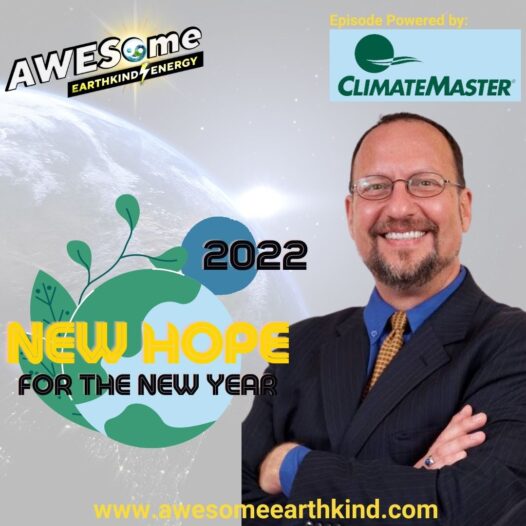Happy New Year, Awesome People!
Welcome to 2022!
The turning of the year provides the opportunity to stop, see where we are, remember the lessons of where we’ve come from, and determine our intentions and goals for the future.
In the first AWESome EarthKind episode over a year ago, we interviewed Denis Hayes, the original organizer of Earth Day who then led the movement that made Earth Day the most widely celebrated secular holiday in the world, involving over 1 Billion human beings.
In that interview, Denis spoke about how there is Always Hope. He recounts several turning points in history where the future was dark and bleak – and yet, despite the odds, people held onto hope and snatched victory out of the jaws of impending defeat.
While today there is much to be rightly concerned about – there are also brilliant starbursts of light that ignite hope and show us a path forward.
Here are some excerpts from the Good News Network (https://www.goodnewsnetwork.org/) and various other sources:
Despite a few national governments continuing to keep their coal and oil projects afloat, market demand and private entrepreneurship is driving what can only be described as a revolution in renewable energy.
These latest achievements were basically unbelievable when global climate change was first being discussed as a serious threat. But today, each successive development of renewable energy generation, clean heating & cooling, and electric cars, makes new achievements cheaper and easier to scale.
Solar for the Developing World
A half million people living in 3 of the Northern Congo cities are going to be supplied with reliable renewable energy by a trio of United Kingdom, French, and Spanish solar power companies.
Citizens from the that region suffer from the lowest rates of reliable electricity in the world. The solar power plants with battery storage will now resolve this problem.
In West Africa, 2 Senegalese cities will find 60MW of solar power available to them in the coming months as a variety of institutions offer government financing for sustainable energy. Senegal is a heavy net energy-importer, placing enormous financial burdens on people for the importatino of coal and oil.
In Nigeria, one of Africa’s largest economies, the Solar Power Naija program will equip 500,000 homes with solar panels, generating electricity for 25 million Nigerians.
Solar on Demand – the least expensive energy source on the planet
The United States National Renewable Energy Lab (NREL) reports that solar and storage costs have fallen dramatically over the past decade. The price of residential solar was reported down from $7.53/W in 2010 to $2.65/W in 2021,; utility-scale solar was $5.66/W a decade ago to $0.89/W today.
That was driven in large part by higher module efficiency and lower module cost.
The combination of low-cost solar farms and lithium-ion batteries has produced a dynamic new hybrid resource capable of providing energy from the sun after dark and reshaping America’s power mix in the 2020s. The spread of these hybrid facilities has been fueled largely by plummeting solar-plus-storage prices, which have begun undercutting conventional fossil-fueled generation.
Levelized solar energy prices – Adjusted for inflation over the estimated 30-year lives of the projects – are in the 2 to 3 cents per kwh range, according to a recent report from Lawrence Berkeley National Laboratory.
Just a few years ago, solar-plus-storage prices were more than triple today’s going rates.
Today, solar and battery storage provide the lowest cost energy on the planet. Last year, 3/4s of all new electric generation capacity in the world was built with solar.
The windiest on record
2021 was the single best year on record for wind turbine manufacturers with 93 new gigawatts (BILLION watts) being added—a 53% increase since 2020. The 2021 Global Wind Report summary states:
“Through technology innovations and economies of scale, the global wind power market has nearly quadrupled in size over the past decade and established itself as one of the most cost-competitive and resilient power sources across the world.”
“Today, there is now 743 GW of wind power capacity worldwide, helping to avoid over 1.1 billion tons of CO2 globally—equivalent to the annual carbon emissions of South America.”
HOT ELECTRIC CARS
Data assembled back in March from Germany’s largest automotive industry review produced a startling statistic – 1 in 5 cars made in Germany can be plugged in.
The Schmidt Automotive Research Center found that 74,000 of the 374,000 cars that left German assembly lines were either electric or hybrid electric vehicles.
On the demand side, things are just as rosy. Germany is the fourth largest auto market in the world, and electric car registrations grew from a 4% national market share in December 2019, to a whopping 26% market share just 12 months later.
This is just in the background of a global surge in EV purchasing that climbed 40% during 2020, when most markets were suffering from COVID-related issues.
Bloomberg New Energy Fund “expects that EVs will make up 20-30% of sales in the United States, European Union and China by 2025, based on “proposed and confirmed rules” in those markets. President Joe Biden has set a goal for half of new passenger vehicle sales in the United States to be electric vehicles by 2030. And New York and others have banned the sale of gas cars by 2035.
2021 is estimated to be “yet another record year for EV sales globally,” with 5.6 million sold. That is 83% higher than 2020 and a 168% increase over 2019 sales.
And global momentum towards zero-emissions vehicles (ZEV) has “accelerated significantly,” Bloomberg said. EVs will “capture a higher share of passenger vehicle sales, sooner than previously expected.”
The green new pension
Since its green shoots 50 years ago, acceptance of ESG (environmental, social, and governance) considerations in institutional investing – especially at pension funds – has evolved with distinct shifts in investor preferences.
As the holders of the largest state-controlled pension fund on Earth, the South Korean monetary authorities released a statement in May that the $771 billion National Pension Fund will cease all investments related to coal power both at home and abroad.
The fund also announced that they would revamp guidelines for investment strategies to ensure a more sustainable pattern emerges in the future.
Worldwide, ESG (Environmental Social & Governance) assets surpassed $35 trillion in 2020 – up from $30.6 trillion in 2018 and $22.8 trillion in 2016 reaching a third of current total global assets under management, according to the Global Sustainable Investment Association.
ExxonMobil – long known for its anti-climate change positions – used to have bragging rights as the world’s most valuable public company with $500 Billion of market valuation. Now, America’s largest oil company is in steady decline. It’s been kicked out of the Dow Jones Industrial Average and has less than half of its peak market value.
Adios, coal: Spain hits 50% renewable milestone
Back in mid-May, the Spanish legislature announced it would be phasing out all oil, coal, and gas production by 2042, and that all carbon-emitting vehicle sales would be banned by 2040.
In the short term, the Spanish lawmakers want 74% of the national energy consumption to be entirely renewable by the end of the decade. They are quite close to that goal already, as the month of May saw 50% of the nation’s energy demand fulfilled by green energy.
Romania also joined the effort, alerting the EU that through its National Recovery and Resilience Plan the country would cease all coal production by 2032, at which time it plans to have installed 34% renewable electricity to take over the baton.
G7, the world’s seven largest developed economies, all agreed to stop coal financing by the end of the year. Now that Japan is also on board, that leaves the African, India, and China as the last remaining holdouts.
In the US, 22 states now have carbon-free energy goals:
| Arizona | 100% carbon-free electricity by 2070 | Adopted by order of the Arizona Commerce Commission in May 2021, extending and expanding the existing state RPS. Docket number RU-00000A-18-0284. |
| California | 100% carbon-free electricity by 2045 | 2018 legislation (SB 100) extended and expanded the existing state RPS. State agencies are required to submit implementation plans by January 1, 2021. Also in 2018, Gov. Jerry Brown’s Executive Order B-55-18 set a goal of statewide carbon neutrality by no later than 2045, with net negative GHG emissions thereafter. |
| Colorado | 100% carbon-free electricity by 2050 for Xcel Energy | A 2019 law (SB 19-236) codified a pledge previously made by Xcel, whose service territory covers approximately 60% of the state’s load. It is mandatory “so long as it is technically and economically feasible.” |
| Connecticut | 100% carbon-free electricity by 2040 | Governor Ned Lamont’s 2019 Executive Order (Number 3) set a 2040 goal for carbon-free electricity and asked the Department of Energy and Environmental Protection to develop a decarbonization plan for the power sector, in line with previous legislation to cut economy-wide carbon emissions by 80% below 2001 levels by 2050. |
| District of Columbia | 100% renewable energy by 2032 through the RPS | The Clean Energy DC Omnibus Amendment Act of 2018 (DC Act 22-583) amended the existing RPS to mandate 100% renewable electricity by the year 2032. |
| Hawaii | 100% renewable energy by 2045 through the RPS | 2015 legislation (HB623) made Hawaii the first state to set a 100% RPS for the electricity sector. |
| Illinois | 100% clean energy by 2050 | 2021 legislation (SB2408) established a goal of 100% clean energy by 2050, with interim targets of 40% by 2030 and 50% by 2040. |
| Louisiana | Net zero greenhouse gas emissions by 2050 | Governor John Bel Edwards’ 2020 Executive Order (JBE 2020-18) established a Climate Initiatives Task Force to develop a roadmap and make recommendations. |
| Maine | 100% clean energy by 2050 | 2019 legislation (LD 1494) increased Maine’s RPS to 80% by 2030, and set a goal of 100% by 2050. Also LD1679 sets an economy-wide goal of 80% cuts to greenhouse gases by 2050. |
| Massachusetts | Net-zero greenhouse gas emissions by 2050 | In 2020, the Secretary of Energy and Environmental Affairs set a 2050 net-zero GHG emissions goal under the authority of 2008 legislation. The same goal was then included in a March 2021 climate action law (Bill S.9). A decarbonization roadmap was released at the end of 2020. |
| Michigan | Economy-wide carbon neutrality by 2050 | Governor Gretchen Whitmer’s order in 2020 (Executive Directive 2020-10) set a goal “to achieve economy-wide carbon neutrality no later than 2050.” It directed the Department of Environment, Great Lakes, and Energy to develop a plan by the end of 2021. |
| Nebraska | Net-zero carbon emissions from generation resources by 2050 for Nebraska Public Power District and Omaha Public Power District; 2040 for Lincoln Electric System | Nebraska is the only state served solely by publicly owned utilities. As of December 2021, the three public utilities that serve the vast majority of customers have all adopted 100% clean energy goals. |
| Nevada | 100% carbon-free electricity by 2050 | 2019 legislation (SB 358) raised the RPS to 50% by 2030, and set a goal of a net-zero emission power sector by 2050. |
| New Jersey | 100% carbon-free electricity by 2050 | Governor Phil Murphy’s Executive Order 28 in 2018 set a carbon free goal for the power sector and directed the BPU to develop an Energy Master Plan, which was released in 2020. |
| New Mexico | 100% carbon-free electricity by 2045 | 2019 legislation (SB 489) requires a zero-carbon power supply by 2050, with at least 80% from renewables. |
| New York | 100% carbon-free electricity by 2040 | 2019 legislation (S6599) requires zero-emissions electricity by 2040 and sets a goal of cutting all state GHGs 85% by 2050. A Climate Action Council will develop a plan. |
| North Carolina | Carbon neutrality in the electricity sector by 2050 | 2021 legislation (HB 951) requires the North Carolina Utilities Commission to “take all reasonable steps” to achieve a 70% reduction in CO2 emissions from electric generating facilities in the state by 2030 and carbon neutrality by 2050. |
| Oregon | Greenhouse gas emissions reduced 100 percent below baseline emissions by 2040 | 2021 legislation (HB 2021) requires investor-owned utilities to reduce greenhouse gas emissions associated with the electricity they sell to 80 percent below baseline emissions levels by 2030, 90 percent below baseline emissions levels by 2035, and 100 percent below baseline emissions levels by 2040. |
| Puerto Rico | 100% renewable energy for electricity by 2050 | 2019 legislation (SB1121), the Public Energy Policy Law of Puerto Rico, set a timeline for reaching 100% renewable electricity by the year 2050. |
| Rhode Island | 100% renewable energy electricity by 2030 | Governor Gina Raimondo’s 2020 Executive Order (20-01) requires the Office of Energy Resources to “conduct economic and energy market analysis and develop viable policy and programmatic pathways” to meet 100% of statewide electricity deliveries with renewables by 2030. |
| Virginia | 100% carbon-free electricity by 2045 for Dominion Energy and 2050 for Appalachian Power Company | The 2020 Virginia Clean Economy Act (House Bill 1526 and Senate Bill 851) requires zero-carbon utilities by 2050 at the latest. |
| Washington | 100% zero-emissions electricity by 2045 | 2019’s Clean Energy Transformation Act (SB5116) applies to all utilities. The state Commerce Department started a rulemaking process in August 2019. Utilities must file implementation plans by January 2022. |
| Wisconsin | 100% carbon-free electricity by 2050 | Governor Tony Evers’ Executive Order (EO38) in 2019 directed a new Office of Sustainability and Clean Energy to “achieve a goal” of all carbon-free power by 2050. |
Natural Gas Moratoriums & Heat Pumps
Dozens of cities, including San Francisco, Berkeley and San Jose in California; Cambridge, Mass.; and Seattle, Oregon have moved to ban natural gas hook ups in new buildings as a way to combat climate change.
In Westchester NY, there has been a moratorium on new natural gas hookups since 2018. And on December 15th, 2021 – New York City banned natural gas hookups for new buildings starting in 2027.
Previously, Geothermal or ground source heat pumps were growing at a rate of 7% per year. Since geothermal is the most efficient form of heating and cooling – with 500% efficiencies from using the stored heat in the ground beneath our feet – it is expected that the growth in both air and ground source heat pumps will soon reach double digits.
Green oil
All is not business-as-usual in the boardrooms of some of the world’s largest petroleum producers.
In a landmark court decision, a judge in the Netherlands ordered Royal Dutch Shell to cut emissions by 45% after 17,000 people brought a lawsuit that Shell’s large greenhouse gas footprint merits a significant investment in CO2-slashing as a debt to society.
Elsewhere in Europe, the Italian oil company Eni became the first European oil company to launch a corporate bond that is linked to sustainability.
The €1 billion 7-year bond is linked to two key performance indicators: “Increasing renewable installed capacity to 5GW by the end of 2025; and cutting the net carbon footprint of its upstream business by 50% by 2024,”
Lastly, Engine No.1, a shareholder group of ExxonMobil, managed to get two of their candidates elected to the American company’s board on the argument that the company’s long-term business strategy didn’t take into account all of the value loss potential from climate change, both from shareholders jumping ship, and potential damages from extreme weather events.
BlackRock, the world’s largest asset manager with $8.6 trillion in private capital, ensured the Engine No.1 candidates got the positions by utilizing their vote as large shareholders.
100% Clean Energy
On April 29th, 2021 over 29 million people in California got 95% of their power from renewable energy— and were contributing virtually nothing towards climate change as far as their electricity needs were concerned.
California follows another major population center, South Australia, which recently fulfilled 100% demand with renewables.
“It sends chills down my spine. It’s amazing,” said Elliot Mainzer, president and CEO of the California Independent System Operator, which runs the state’s main power grid. “These types of transitions aren’t always pretty. But we’re getting a lot of renewable generation online, making a real dent in the state’s carbon emissions,”
Mainzer recently urged the state to construct another 10,000 megawatts of renewables, an equivalent of one-eighth of the entire state baseload power, in order to cover the gaps in the grid.
Covering gaps in renewables is important for two reasons. The first is that electricity is the only resource that must be consumed as soon as it’s produced. That means projections of demand must always be just about perfect.
The second reason is that renewables most often have no form of storage, and the electricity they generate goes into the grid immediately upon production.
To help navigate around these natural flaws in renewable energy, California has been a key leader in coordinating with other states in the west to share surplus power across state lines, creating a more robust grid, removing more need for fossil fuels, and taking advantage of other states’ resources.
For example, California is much sunnier than Wyoming, but Wyoming has the most consistent wind power of any state. Utility companies in each place can exchange their baseload power with the strengths of the other and reduce fossil fuel input and increase grid stability.
This is the best method for protecting against blackouts and drops in supply due to changing weather until cost-effective and scalable storage technology become widely implemented.
A Clean Economy = Healthier Communities
Scientists at UC Berkeley are hailing the state’s diesel engine standards for drastically dropping the amount of diesel particulate matter in the air, and reducing the cardiopulmonary deaths attributable to poor air quality.
If you never saw the pictures of the city of Los Angeles before the Clean Air Act, they look like something out of the movie Escape from L.A. But encouraging shifts away from high-sulfur fuels, and replacing diesel ships with electric ones, has gradually scaled the horror show back.
“Our analysis of mobile-source DPM (diesel particulate matter) emissions suggests that many California sector-based policies have been highly effective,” write the authors of the paper published in Science.
They found that from 1990 to 2014, the amount of DPM in the California skies fell by 78%, while cardiopulmonary and cancer deaths linked to diesel pollution dropped by 82%.
These are just some of the many positive actions that have been happening around the country and globe.
Obviously, there still much to be concerned about.
As I record this podcast, I have one son in Boulder Colorado whose former home community was destroyed by the recent wildfires. Only 1 mile away from his current home, 100 mph winds created a blast furnace of destruction for thousands of homes.
Thankfully, the massive snowfall has now contained that catastrophe. But my other son and his family were pummeled by 11 feet of snow on the way to their holiday vacation in Lake Tahoe.
Don’t Look Up
If you haven’t seen the new comedy film “Don’t Look Up” – it’s worth watching. While the insanity of ignoring science is pretty funny – the reality is that we can’t allow ourselves to continue to be distracted by day-to-day petty politics and our ridiculous obsession with social media.
We all need to join together, find a way to overcome our differences, and remember that our children’s future is the one overriding priority that we all share.
Creating a sustainable planet is a huge task. But as the recently deceased Desmond Tutu once wisely said: “there is only one way to eat an elephant: one bite at a time.”
Figure out how to take your bite – and let’s all keep moving forward, one small bite at a time…
Has your workplace conducted a Greenhouse Gas Inventory? Is there a clean energy plan to achieve sustainability goals?
Schedule an initial FREE Consultation with EarthKind Energy Consulting to discuss how your workplace can save money and reduce your carbon footprint.
Contact us at www.EarthKindEnergy.com
- Ron@EarthKindEnergy.com
- P: 845-266-3723
Wherever you are on your clean energy journey – we’re here to help you take your next step.
Please let us know what you need by going to AWESome EarthKind dot com and clicking on “Tell Us”.
When you fill out the online survey, you’ll automatically be entered into a Sweepstakes for a Free LED Light Fixture worth $150.
Or… call just us at 845-266-3723







